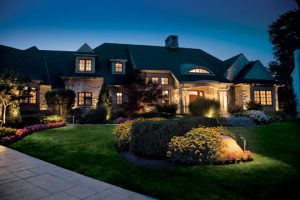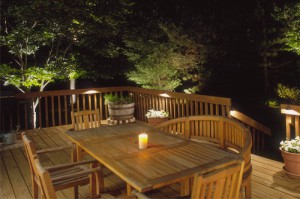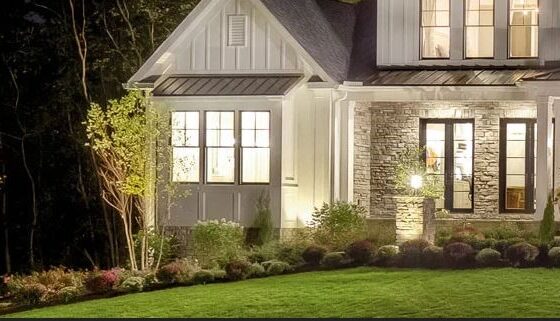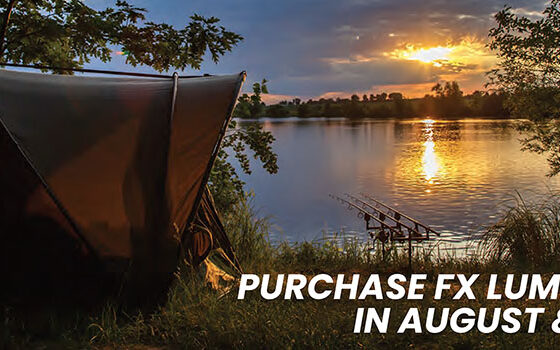 The key to installing any successful project is to start with a good design. For landscape lighting, like many other projects, there are several key things to ask and observe before you start.
The key to installing any successful project is to start with a good design. For landscape lighting, like many other projects, there are several key things to ask and observe before you start.
The first thing you may run into is that many homeowners equate landscape lighting with only path lighting. Landscape lighting has a lot more potential than just sticking path lights in the mulch. A good lighting design will use a number of different techniques (up lighting, down lighting, hardscape lights, path lights, etc.) focusing on trees, architecture, yard art, walkways, etc. The best, most cost effective ways to “wow” your clients is to seamlessly blend all of these options. This is what sets a good installation apart and what will have customers seeking you out.
Things to Consider
Some things to consider at the planning stage:
- Property layout (what can you illuminate to enhance the landscape and architecture?)
- Discuss how the property is used (entertaining, kids, pets, sports, visitors, etc.)
- Determine where lighting is needed to allow for safe passage (walkways, steps, patio edges, pool, etc.)
- Observe the exterior perimeter of the house and landscape for appropriate items to illuminate
- Go inside the home and confirm window views to the outside
- Where do the property owners sit and watch tv, read the paper, eat meals, do the dishes, etc. (what are the exterior views from these locations?)
Ultimately you need to determine who you are designing for: the homeowner’s enjoyment, or passersby (curb appeal), or both. Illuminating the front of a house is typically done to enhance curb appeal, but for most homes the owners only see the house facade while they’re pulling in and out of the garage at night. It’s beautiful and it adds tremendously to the value of the home, but facade lighting is not typically lighting that puts on a nightly show for the occupants of the home.
Where to Light
As noted above, finding out what the exterior views are through the windows in the “busiest” parts of the house is essential to deciding what to illuminate in the more private areas of the home and landscape (patio/deck, backyard, pool deck, gazebo, etc.). Patio/deck lighting can be very pleasing and extends the use of our outdoor spaces, but most of us tend to view our landscapes from the inside of our homes. This is why the window views are so important to lighting.
 You may discover that a key window view has nothing of substance to illuminate. As a designer, you need to discuss that with your client and decide if there is something that can be placed or planted there to create a focal point. At a basic level, you’re lighting up things in the landscape, at a higher level, you’re adding beautiful artwork to their walls and they just need to look out the windows to enjoy it.
You may discover that a key window view has nothing of substance to illuminate. As a designer, you need to discuss that with your client and decide if there is something that can be placed or planted there to create a focal point. At a basic level, you’re lighting up things in the landscape, at a higher level, you’re adding beautiful artwork to their walls and they just need to look out the windows to enjoy it.
There are many different ways to approach designing a lighting project, but one method is to use the following hierarchy to help determine what areas to illuminate.
- Safe passage (walkways, paths, steps, changes in direction, patio edges, etc.)
- Entry points (doors, gates, etc.)
- Landscape (trees, yard art, decorative fences, etc. / especially things visible through windows)
- Hardscapes (decks, patios, seat walls, pergolas, etc.)
- Architecture (facade, weather vanes, dormers, cupolas, etc.)
- Specialty elements on the property (wooded areas, boat docks, fire pits, etc.)
What We See
Physiologically, humans see vertical surfaces before we see the horizontal plane. So up lighting trees has more impact than illuminating the ground with path lights. One thing that path lights and/or down lights are good for is to add “fill light” between illuminated trees and structures. This ties together vertical elements with transitional light so the scene is more cohesive.
There are ten different lighting techniques that can be used to achieve various effects:
- Path Lighting (path lights used to illuminate walk ways, etc.)
- Spread (illuminate ground but not path ways)
- Shadow (need wall or some sort of surface adjacent to illuminated item)
- Silhouette (need wall or solid surface behind item to be silhouetted)
- Grazing (best with rough surfaces like stone, brick, stucco, etc.)
- Spot Lighting (focal point(s) within the landscape)
- Up Lighting (typically ground mounted fixtures directing light straight up)
- Down Lighting (typically tree or surface mounted fixtures directing light downward)
- Cross Lighting (two or more fixtures positioned to up light or down light; adds more dimension)
- Mirror Lighting (need pool of water so illuminated items are reflected)













I’ve been thinking about getting some new landscape lighting, and I think that some tips would be good. I’m glad you talked about being able to have lighting help with the landscape and decoration. I’m going to have to look for a few good landscape lighting options and see what we can find!